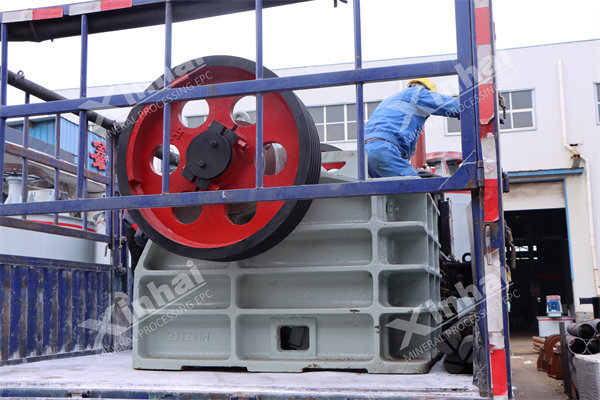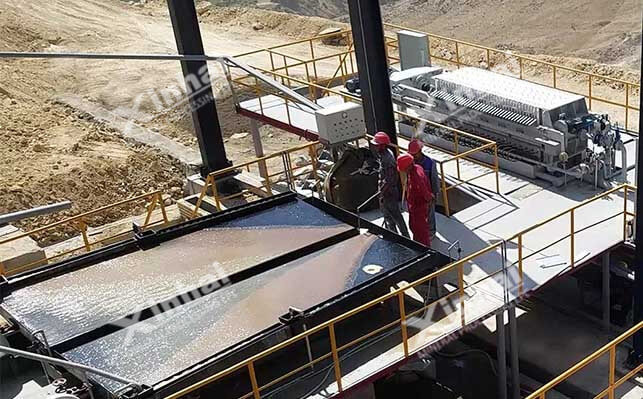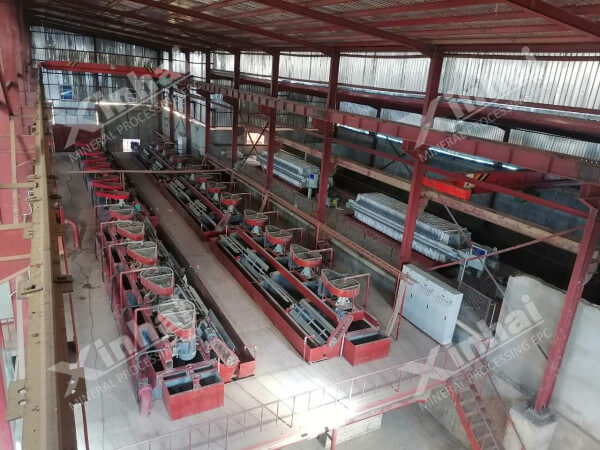Appropriate mineral processing equipment can effectively separate tin minerals from impurities and is a key factor in achieving efficient and high-quality production. So what equipment is needed for tin mineral processing? The main ones are as follows:
Before separating tin ore from impurity minerals, the large pieces of tin ore must first be crushed. In the coarse crushing process, jaw crushers are often used. They crush ore through the relative movement of two jaw plates. With a large crushing ratio, they can effectively crush large pieces of ore into smaller particles, preparing for subsequent grinding and beneficiation processes to ensure uniform product particle size.
In addition to jaw crushers, cone crushers and other crushing equipment are also selected in the secondary and fine crushing stages to further complete the crushing operation, so as to reduce the particle size of the ore entering the grinding stage, thereby reducing energy consumption and saving production costs.

After the tin ore is crushed by the crushing equipment, it is sent to the ball mill. It grinds the ore into fine powder through the impact and grinding action of the steel balls to meet the requirements of the subsequent mineral processing process. The ball mill has the characteristics of large processing capacity, which can process a large amount of ore in a short time and improve production efficiency. At the same time, it has strong adaptability and is suitable for fine grinding of ores of various particle sizes. However, the ball mill also has some problems, such as high energy consumption and a large amount of electricity consumed during operation.
In addition, fast wear is also a disadvantage of the ball mill. The steel balls and liners are prone to wear during long-term use and need to be replaced regularly, which increases maintenance costs.
The gravity separation process mainly uses the difference in specific gravity between ores to separate useful minerals and impurities in tin ore beneficiation. Through this process, impurities such as quartz, feldspar, and light minerals can be removed. Commonly used tin ore gravity separation equipment includes spiral chute, jig and shaker.
(1)Spiral chute
The working principle of the spiral chute is to use the difference in sedimentation speed of ore particles in the water flow for sorting. It has the advantages of simple structure and convenient operation. Operators only need to perform simple operations to achieve ore sorting. At the same time, the spiral chute has a large processing capacity and can process a large amount of ore per unit time. The sorting effect is good, especially suitable for processing ores with finer particle size, and the recovery effect of fine-grained tin ore is remarkable.
(2)Jig
The jig can mix mineral particles with different specific gravity and stratify them according to specific gravity in the vertically moving variable-speed medium flow. Minerals with small specific gravity are located in the upper layer and minerals with large specific gravity are located in the lower layer. By using the action of machinery and water flow, the jig will be separated into layers. The layered materials are discharged separately. The jig is especially suitable for sorting coarse-grained minerals. For sand tin ore with a high degree of monomer dissociation, it only needs to be screened out through simple screening to screen out the large pieces of waste rock that does not contain tin, and then go through the jig machine. By gravity separation, good sand tin ore beneficiation indicators can be obtained. The process operation is simple, the selected particle size is large, the selected particle size is wide, and the equipment processing capacity is large.
(3)Shaking table
The shaking table drives the bed surface to perform longitudinal reciprocating motion through the transmission mechanism, and performs flushing and differential motion of the bed surface. During the reciprocating motion, the mineral particles undergo delamination perpendicular to the bed surface and separation parallel to the bed surface, so that Materials of different particle sizes are discharged from different sections of the bed surface to achieve sorting. The shaking table is particularly suitable for processing and sorting minerals with finer particle sizes. For sand tin ore with a low degree of monomer dissociation, part of the over-ground tin ore cannot be fully recovered on the jig during the rod milling process. At this time, the second stage The jig tailings are subjected to shaking table gravity separation to recover the fine cassiterite present in the tailings, thereby increasing the recovery rate.

Since cassiterite gravity separation has low separation efficiency for tin minerals with particle sizes below 19 μm, flotation has become one of the important ways to recover fine-grained tin minerals. In order to improve the flotation effect of fine-grained cassiterite, the fine-grained tin minerals can be pretreated before flotation, such as vigorous stirring of the slurry, classification by large-diameter hydrocyclones, and desliming by small-diameter hydrocyclones.
Effective flotation reagents and equipment combinations can also be used, such as a combined unit consisting of a KYF flotation machine and an XCF flotation machine. XCF is used as a suction tank and KYF is used as a DC tank to achieve horizontal configuration without the need for a foam pump; the U-shaped tank shortens the flotation distance as much as possible, the slurry flows to the bottom of the tank, and the rotor suctions to the gap between the impeller and the stator, which is beneficial to Coarse and heavy mineral particles return to the impeller area for recirculation to avoid accumulation of mineral sand and reduce slurry short circuit. This combined unit greatly reduces equipment management and maintenance operations, reduces system energy consumption and investment costs, and significantly improves the beneficiation efficiency of fine-grained tin ore.

Magnetic separator is used to separate magnetic minerals and non-magnetic minerals in the tin ore beneficiation process. It uses the effect of magnetic field to adsorb magnetic minerals on the magnetic separation cylinder to achieve separation. The magnetic separator has a large processing capacity and can process large amounts of ore quickly. The sorting effect is good and can effectively separate magnetic minerals from non-magnetic minerals. It is easy to operate, and the operator only needs to perform simple operations to achieve mineral sorting. It is suitable for processing tin ores containing magnetic minerals. For example, some tin ores often contain various iron oxide minerals (such as magnetite, hematite, limonite, etc.), tungsten ore and other symbiotic minerals. Magnetic separation operations can achieve tin Iron separation.
(1)Concentrator
The concentrator is used to concentrate the slurry in the tin ore beneficiation process. It uses gravity sedimentation to settle the solid particles in the slurry to the bottom of the concentrator, thereby achieving concentration of the slurry. The concentrator has a large processing capacity and can process a large amount of slurry per unit time. It has good concentration effect and can effectively increase the concentration of slurry. Simple operation, easy to master and operate.
(2)Slurry pump
Slurry pumps are used to transport slurry in the tin ore beneficiation process. It transports the slurry from one process link to the next through the rotation of the impeller. The slurry pump has strong conveying capacity and can convey high concentration and highly abrasive slurry. It has good wear resistance and can resist the wear of the slurry during the transportation of the slurry. The long service life reduces the frequency of equipment replacement and reduces production costs.
(3)Chemical mixing tank
The chemical mixing tank is used for dissolving chemicals and stirring slurry in the tin ore beneficiation process. It uses the rotation of the agitator to fully mix the agent and the slurry, thereby improving the mineral processing effect. Stir evenly to ensure that the agent is evenly distributed in the slurry. Easy to operate, easy to master and operate. It has large processing capacity and can process a large amount of slurry per unit time.
The above gives you a comprehensive introduction to tin ore beneficiation equipment. In addition, with the continuous advancement of science and technology and the continuous improvement of technology, tin ore beneficiation equipment is developing in a more efficient and intelligent direction, opening up a broader development space for the tin ore processing industry. In the future, tin ore beneficiation equipment will continue to move forward on the road of high efficiency and intelligence, while paying more attention to green environmental protection, bringing greater development opportunities and space to the tin ore processing industry.